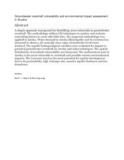Groundwater overdraft vulnerability and environmental impact assessment in Arusha
Abstract
A simple approach is proposed for identifying areas vulnerable to groundwater overdraft. The methodology utilizes GIS techniques to analyze and evaluate controlling factors in areas with little data. The proposed methodology was applied in Arusha. Water demand in Arusha Municipality and its environs has increased to about 5.3% annually since 1999. Groundwater levels have declined. The aquifer hydrogeological variables were evaluated for impact to potential groundwater overdraft by overlay and index techniques. The spatial distribution of overdraft vulnerability was discussed. The northwestern part of Arusha is the most vulnerable to overdraft and possible serious environmental impacts. The Loruvani area has the most potential for aquifer development due to its permeability, high recharge rate, massive aquifer thickness and low drawdown.
URI
https://doi.org/10.1007/S00254-006-0408-9https://link.springer.com/article/10.1007/s00254-006-0408-9
http://r-library.mmust.ac.ke/123456789/1690
Collections
- Gold Collection [1026]

